Perhaps you have had moments in your musical life when you have felt like a fraud or not “good enough”. Even after people have heard you perform, seemed to enjoy it and paid you a compliment – you still are not convinced and think “Yeah, but…”.
Perhaps you focussed on the small errors in the overall performance or you think the listener was just “being nice”, or, “They don’t know much about music anyway.” Maybe you think that you just worked harder than everyone else and that the really good musicians don’t seem to have to put in the same effort.
Well here are three bits of good news for you:
- Firstly, you are wrong. (And it was probably a lot better than you give yourself credit for.)
- Secondly, Imposter Syndrome is a behavioural response to a stressful stimulus. We can relearn our habitual response to that stimulus.
- Finally: you are not alone!
You’re in good company
The High Priestess of Soul, Nina Simone, had it too,
“The worst thing about that kind of prejudice… is that while you feel hurt and angry and all the rest of it, it feeds your self-doubt. You start thinking, perhaps I am not good enough.”
It’s not easy being an artist. Apart from fighting that “not good enough” feeling, struggling to make the music you want is a natural part of art. Just because you are struggling, and music may not feel “natural” in the moment, does not mean you are not good enough.
Perhaps this is a great place to start. Find a quote on “doubt”, “not good enough”, or “failure” by a musician you admire. You won’t have to search very long. Let this person be your role model. If they can fight through their Imposter Syndrome, you can too. Struggling through. Working through your doubts is a big part of art.
The Struggle of the Artist
Over to Billie Holliday:
“People don’t understand the kind of fight it takes to record what you want to record the way you want to record it.”
Know this: it is this struggle that sets you apart from everyone else. If it was easy, everyone would do it[1].
Instead of accepting the struggle, people with IS see themselves as failing and give up. Like Billie, your struggle to get your music the way you want it is a measure of your determination and hard work. Accepting the challenge of that struggle is what makes you an artist.
Table of Contents
2. What Imposter Syndrome Is Not
3. A Very Brief History of Imposter Syndrome
4. Where Does Imposter Syndrome Come From?
5. What Type of Imposterism Might You Have?
6. Imposter Syndrome in Action – A Short Story From The Author
7. The Imposter Syndrome Cycle
8. The Imposter Cycle as a Vicious Circle
9. Avoiding the Imposter Cycle
10. Moving Away From Imposter Syndrome
11. Healing Imposter Syndrome in a Big Way
12. Language
13. Final Thoughts
What Imposter Syndrome is
Imposter Syndrome is the feeling of being a fraud, of feeling like a fake. It is the feeling of not being good enough and the fear of being “found out”. It is a false belief and a normal response to a stressful stimulus, or “trigger”. It affects capable people (that’s you!), including a whopping 70% of high-achieving senior executives[2].
Worth

And this is what we want to change.
We want to internalise our sense of worth and associate it with our own values – not base it on the actions of others. When we can internalise our worth so that we are now in control of it, we have achieved unconditional worth.
What Imposter Syndrome is not
Imposter Syndrome is not low self-esteem, a lack of confidence, and incompetence. It is not a psychological condition – although, if left unchecked, in extreme cases IS can create psychological conditions such as depression.
Victim Mentality
Closely related to “conditional worth” is the tendency to identify with the condition – whether it comes from society, family, or even physical reality. When we identify with the condition, then we deny our power to change that condition, or change our own response to that condition.
In other words, we become powerless victims rather than responders and creators. How we choose to use our language can help turn this around.
So, Imposter Syndrome is something we have, not something we are.
IS does not define your identity.
Further examples:, it’s important not to say “so-and-so is dyslexic”, but “so-and-so has dyslexia” – because the person is not the condition. You do not say they “suffer from blindness” because the person is not a victim. You say “they have Imposter Syndrome” because it is but one attribute of an empowered person.
Can you see how changing the way we use language is a very simple and powerful tool to create change?
A Very Brief History of IS
1974 – Pauline Clance first uses the term Imposter Phenomenon in her research1978 – Pauline Clance and Suzanne Imes publish the first paper on Imposter Phenomenon.
Initially, IS was believed to mainly affect women
1985 – Pauline Clance publishes the first book on Imposter Phenomenon and the Clance Scale[3]
2011 – Valarie Young publishes “The Secret Thoughts of Successful Women”
IS is understood to affect all minorities and disempowered social groups.
2017 – An explosion of books about imposter syndrome on the market.
IS is understood to have the potential to affect everyone.
Because the surge in recent interest for IS has only occurred in the last three years, it would be impossible for any adult living in 2020 to have had the issue addressed as such when they needed it most, when it started to arise in childhood. What is the ultimate effect of IS on your music?
One of the things people with IS need to do is to deepen their connection to their success. We have to learn to stop giving away our achievements saying, “It was luck,” or “I know the right people,” or “I was in the right place at the right time,” or “They just happen to like me.”
Sure, those statements may be true. But those events represent an opportunity and if you do not come up with the goods, the same people will not offer you another chance.
“Luck” might open the door, but you still have to walk through it.
If they came back to you a second time, that’s not luck, that’s the reward for your effort to seize the opportunity you were given. Many people with IS are not good at taking time out to celebrate small victories.
Exercise
Now is a good time to find somewhere secluded and quiet and take a bow, making a moment to savour your success. Did that feel a little cheesy to you? Perhaps you have difficulty accepting your success. Maybe deepening your connection to your success so it feels natural, not cheesy, is an area you need to work on.
Accepting our Success
So, if we as people with IS do not readily accept our success, what is it we are accepting?
We are accepting less than our full potential. Your last success is a stepping stone to greater heights in your next project. Not accepting this success will undermine you to take on your next challenge. By not acknowledging your success, you cannot become the artist you want to be.
Failure: The Ultimate Consequence of Imposter Syndrome on Your Music
“The only difference between practicing artists and failed artists is practicing artists have not stopped failing” (Bayles & Orland, 1993)
We are accepting failure as the outcome and allowing it to put a brake on our success. Why is it so difficult to feel success, to feel good enough? Because, as Stanley Kunitz said, “The poem in your head is always perfect.”
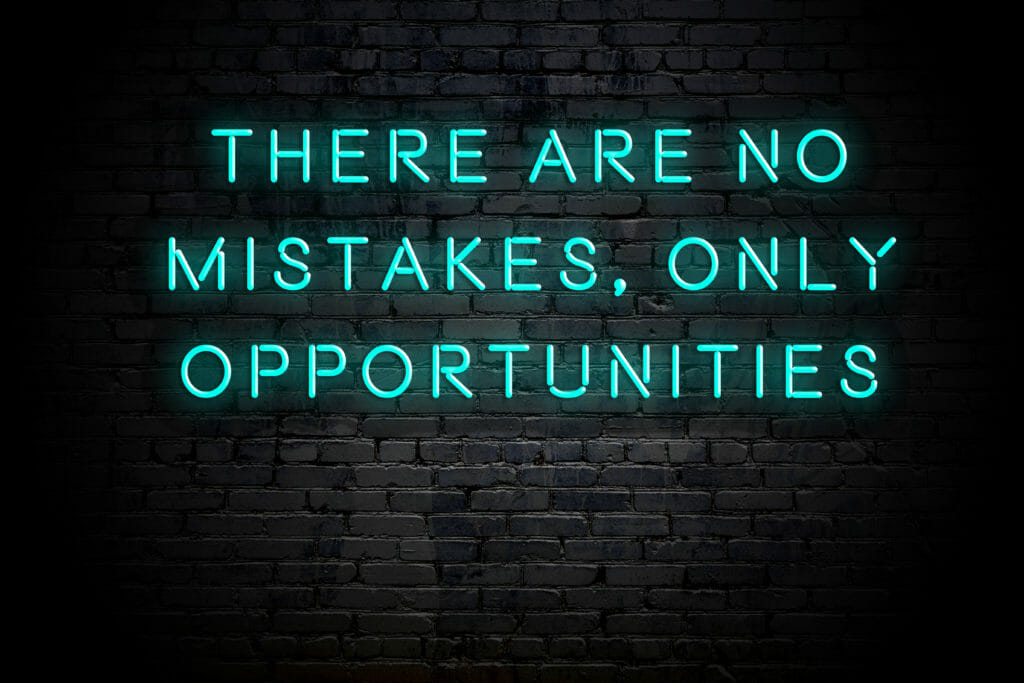 As Bayles and Orland point out, “the piece you make is always one step removed from what you imagined”. We could read that as “I have failed to produce what I intended,” as “I am not good enough, I am a fraud,” when our creative output does not match our vision.
As Bayles and Orland point out, “the piece you make is always one step removed from what you imagined”. We could read that as “I have failed to produce what I intended,” as “I am not good enough, I am a fraud,” when our creative output does not match our vision.
In reality, this is but one interpretation of our vision.
Here’s another interpretation: errors are an opportunity to learn. You can take this learning as the seed for your next work (which is a point Bayles and Orland make). Their book is compulsively quotable and I’ll have to stop there before we get done for copyright infringement.
That can be your first assignment. Find a copy of “Art and Fear” in your local library, or better still, buy a paperback. If you enjoy it as much as I did, it will be scrawled-on and annotated within an inch of its life.
Failure in music does not lead to calamity
Some careers are very demanding and you need to be perfect every time. If 99% was good enough for air traffic controllers and doctors, 11 planes would crash daily at JFK International Airport, and the NHS in the UK would have 200 failed operations per day. Thankfully, no one is going to die if we, as musicians, play a wrong note. If we are measuring our success by these life-or-death standards then we need to rethink our attitude towards failure and mistakes.
In one of Frank Zappa’s last interviews during his 1993 Salad Party when he was recording with Johnny “Guitar” Watson, the Chieftains (a traditional Irish band), and Huun-Huur-Tu (a Mongolian folk band) he said,
“I’m experimenting – it doesn’t have to be good.”
Check out Frank Zappa’s back catalogue – the sheer volume of music must be second only to the Grateful Dead. Most Zappa fans will admit not all of that mountain of music can be great. Zappa knew that too. He saw every opportunity to make something as a moment to learn, to grow. The world needs more Zappas. Let’s grow Frank Zappa’s attitude.
The last word on failure goes to Marilyn Monroe,
“Just because you fail once, doesn’t mean you’re gonna fail at everything.”
So this is what we want to do in this guide:
- rethink our attitude to “good enough”,
- reassess failure as a consequence of IS,
- rethink failure as an opportunity to learn and grow,
- understand where our imposter syndrome came from, and
- have a look at some strategies to give us long-term behavioural change so we can enjoy the success we truly deserve.
IS creates a mindset where you feel you are “not good enough”. When you feel “not good enough”, you set up an expectation that you will fail. It becomes your belief, a self-fulfilling prophesy. As Henry Ford said, “Believe you can or believe you cannot, either way you are going to be right.”
Before we dive into strategies we can use to combat IS, let’s see where IS came from so we know the enemy.
Where does Imposter Syndrome come from?
As is often said, “you were raised by humans”. This is not a blame game levelled at our parents. Blame is a disempowering victim mindset. We want to take control of all our actions and blame has no role here. The humans who raised us were also raised by humans until we go so far back that we were raised by very hairy humans. We can be the first generation since we came down from the trees to break the cycle. How empowering is that?
 Our IS came from a basic survival need. When we were vulnerable infants, we depended on our parents for our survival. This affected us in two ways, conditional worth and labels. They both set the expectations we imagined others had for us.
Our IS came from a basic survival need. When we were vulnerable infants, we depended on our parents for our survival. This affected us in two ways, conditional worth and labels. They both set the expectations we imagined others had for us.
To increase the chances of making it through Darwinian selection, we needed to win our parents’ approval and conform to family and social norms. We did this by ensuring that our actions would maximise our acceptance and survival. Your parents did the best with what they had and encouraged you as they thought best. This process of measuring your worth to win the approval of others was learnt in your infancy.
Attaching a sense of self, your worth, to the reactions of others is where we get into conditional worth. Conditional worth is external to you and therefore you cannot control it.
In contrast, unconditional worth is the complete internalization of your sense of self so that you are no longer dependent on the response of others for your feeling of worth. Your actions are in complete alignment with your values and not the values you imagine others expect of you. According to Tara Halliday, only 1 in 100,000 people develop unconditional worth unaided. To kick our IS habit, we need to develop unconditional worth. It is a long road, but if you don’t start it, you won’t get anywhere.
Labels
Labels are just as bad. Parents, to make us feel special and give us a unique place in the family, use them. Some of the most common labels are,”The smart one”, “The talented one”, “The musical one”, “The funny one”. I’m sure you get the idea and perhaps you can think of some different ones that were used in your family. While it is great that our parents wanted us to feel special, giving us a label meant we had to live up to the title because this is why our parents thought we were special. This was how we won acceptance.
How Does IS Affect Other Areas of your Life? Other People?
Do you avoid speaking up at work? Do you avoid taking on extra responsibilities at work?[4] If the fear of being found out at work is stressful, how does that affect your physical and mental health? How does it affect your relationships if you are not able to fully relax from the anxiety of returning to work? In extreme cases, IS can lead to dependency issues and depression. This is when some people with IS may need to go beyond a guide or coach and talk to a psychologist or counsellor.
What Type of Imposterism Might You Have?
Not all IS is the same. With different childhoods, we were presented with different ways to win approval and developed our own strategy to maximise our conditional worth. As adults, this became a pattern of behaviours which is identified as an imposter type. Valarie Young has identified five imposter types:
- The perfectionist,
- The natural genius,
- The expert,
- The sole-trader, and
- The superhero
1. The Perfectionist
The Problem
 Setting overly high standards can make you very difficult to work with. Maladaptive perfectionism prevents us from adjusting our behaviour in the face of evidence. It sets impossible standards and undermines our happiness by considerably adding to our stress.
Setting overly high standards can make you very difficult to work with. Maladaptive perfectionism prevents us from adjusting our behaviour in the face of evidence. It sets impossible standards and undermines our happiness by considerably adding to our stress.
A Solution
Try and redefine what you mean by 100%. 100% gets the job done and keeps everyone happy. This is not lowering your standards. Chasing the Shangri-la of perfection will never end, and you will never feel satisfied. In fact, the fear of making a mistake can create paralysis leading to procrastination.
2. The Natural Genius
The Problem
“If it doesn’t come naturally, leave it” – so sang Al Stewart on “Year of the Cat”. The next line goes, “She may have been wrong, she may have been right”. Fortunately, she was wrong. Although, to be fair, a lot has changed in our understanding of the brain and learning since this album came out in 1976. Thankfully, Anders Erickson, Caroline Dweck, Terry Sejnowski and others have debunked the myth of the “natural genius”.
 Dictionary.com says, “Competence is the quality of being competent; adequacy; possession of required skill, knowledge, qualification, or capacity.” Skill, knowledge, qualification and capacity do not happen overnight. They take time and effort. In fact, early bloomers can hit a wall and fall by the wayside mid-career. Barbra Oakley notes this in her book “How to Learn” when discussing chess prodigies. It was the B grade child chess players (not the A grade) who went on to become chess grandmasters. The B graders had to struggle to build mental models to solve problems. As the game became more challenging, B grade players had a problem-solving toolbox that the A grade players did not. Eventually the B grade players outpaced the prodigies. This outpacing by the “almost rans” was not because of natural talent but because of hard work. “Tortoise and Hare”, anyone?
Dictionary.com says, “Competence is the quality of being competent; adequacy; possession of required skill, knowledge, qualification, or capacity.” Skill, knowledge, qualification and capacity do not happen overnight. They take time and effort. In fact, early bloomers can hit a wall and fall by the wayside mid-career. Barbra Oakley notes this in her book “How to Learn” when discussing chess prodigies. It was the B grade child chess players (not the A grade) who went on to become chess grandmasters. The B graders had to struggle to build mental models to solve problems. As the game became more challenging, B grade players had a problem-solving toolbox that the A grade players did not. Eventually the B grade players outpaced the prodigies. This outpacing by the “almost rans” was not because of natural talent but because of hard work. “Tortoise and Hare”, anyone?
A Solution
Just as with the Perfectionist, you need to accept that making music is a process. The final performance is a product but 99% of the time you are in preparation to get there. 99% of the time you are a work in progress. Try and shift your mindset from perfect product to progressive process. This makes the task durational and not a moment in time.
If you can accept that tasks rely on the process of time to progress, then you can accept that you will grow into the end point from the starting place. You will have accepted that learning is a necessary part of success and this debunks the natural genius theory.
Thus, less rides on any one moment. This is a powerful mental shift.
The Expert
The Problem
One of the hardest things in producing a research thesis is knowing when to stop researching and start writing. This is for a number of reasons. The most important one for us is “Do I know enough to do it?”
A relentless chase for knowledge can be a cloak for procrastination.
 Procrastination covers for fear of failure. So admonishing yourself for not knowing enough to get started is just another way of avoiding failure. The Decision Education Foundation define 100% information as “having enough to get the job done”. Any more is a waste of effort. Leading advisors, who charge large consultancy fees, consider themselves experts with 60% specialisation in their field. The other 40% they learn and research as they need to.
Procrastination covers for fear of failure. So admonishing yourself for not knowing enough to get started is just another way of avoiding failure. The Decision Education Foundation define 100% information as “having enough to get the job done”. Any more is a waste of effort. Leading advisors, who charge large consultancy fees, consider themselves experts with 60% specialisation in their field. The other 40% they learn and research as they need to.
In academic terms, that’s not even a first class honour!
Real experts learn as they go. They cut themselves some slack. Becoming an information addict is a real thing – it’s called KAS, or Knowledge Acquisition Syndrome. There is a very real chance that you will disqualify yourself from a great opportunity if you discount yourself for lacking minor skills. Just like the Perfectionist, in the overall picture, this small skill probably does not matter. Or if it does, you can find someone who can help you.
A Solution
Find a self-taught role model. Many successful musicians worked it out as they went along and built their expertise through effort, trial and error.
Look at the debut album and more mature work of artists you admire. What do you notice? How have they grown? Sure, there will always be one-hit wonders. Leave them out and look at someone who has left a legacy. Bowie is a great example. His last album “Black Star” completely redeems his mid-career Tin Machine debacle. So are the Beatles, they were always changing and growing. Compare “Please, Please Me” to “Abbey Road”.
Mr. or Ms. Solo (Napoleon or Han, your choice)
The Problem
The feeling “I have to do it all – or at least know how to do it or I am not the real deal” is very common. “Delegation is for sissies!”
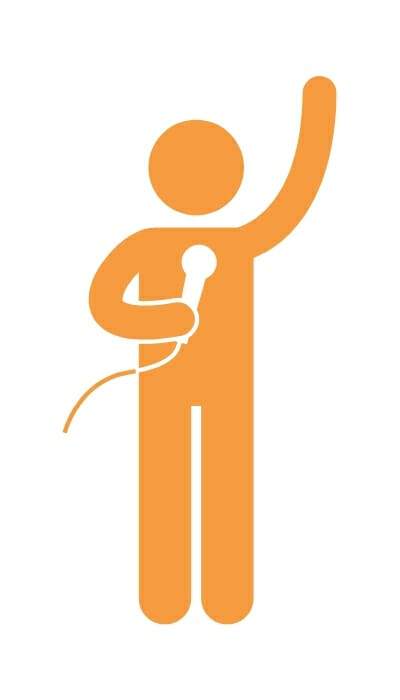 When interviewed about his debut solo album Dream of the Blue Turtles, Sting said that it is not a solo album. There was so much expectation for his first album after The Police broke up, that to get it the way he wanted, more people worked on it than on the final Police album, Synchronicity.
When interviewed about his debut solo album Dream of the Blue Turtles, Sting said that it is not a solo album. There was so much expectation for his first album after The Police broke up, that to get it the way he wanted, more people worked on it than on the final Police album, Synchronicity.
Ask Ed Sheeran how many people helped him get to where he is now. He comes across as a genuinely humble guy. I’m sure he would be sending out thanks like pellets from a rapid-fire pump action shotgun.
Would you have started to learn music if you had not heard a piece of music that resonated with you? Of course not. That initial influence shows us we are never alone. We are always influenced by one another.
The Solution
Identify the people who can complement you. What did The Band do for Dylan? “The Last Waltz” is still one of the greatest rock documentaries ever made. Learn to collaborate. Who can complement the skills you lack? What would Jagger be without Richards, Lennon without McCartney, or David without Bacharach?
Heroes
The Problem
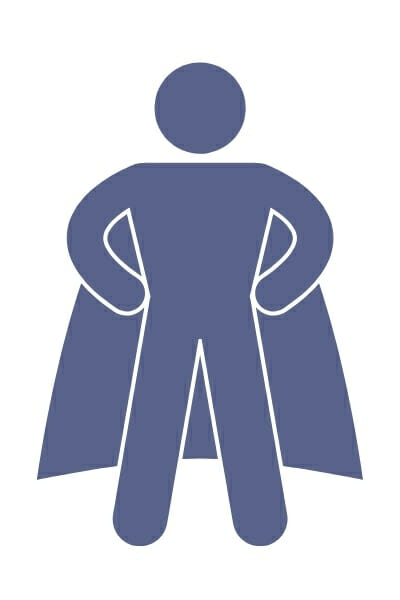 “We can be heroes, just for one day“, sang David Bowie. But as a long-term strategy, you’ll be a Space Oddity and burn up on reentry, Major Tom.
“We can be heroes, just for one day“, sang David Bowie. But as a long-term strategy, you’ll be a Space Oddity and burn up on reentry, Major Tom.
Trying to be the hero, being all things to all people, all the time, and doing it all at the same time won’t end well. The power of multitasking is a myth. So much research has debunked it. Do one thing at a time well and then move on when you have finished. That’s how successful people manage multitasking. They also ask for help when they need it.
A solution
Research the career of a person you admire. How do they manage all the things their success requires of them? How do they juggle those roles without dropping the ball? You probably do not need to go as far as Bob Dylan (who has his own historian-in-residence for his website, Sean Wilentz) but you probably could do with a little help from your friends.
Imposter Syndrome in Action – A Short Story From The Author
This is a story about a friend of mine and maybe you can relate to it. HB is a good friend and one of the best musicians I know. When we were in college (doing what college kids do), HB would join us from time to time but outside of that she put in long hours playing music, writing songs, and honing her craft. She produced music while we went to the bar and produced a hole in our pockets. She would play open mic nights around Dublin and as her stage craft improved, her performance got better and better. She began to regularly win open mic nights and used this as leverage to have agents come and listen. She eventually got a contract to make an album with an option for two more. She was paid an advance. This was everything she wanted – an opportunity to be a professional musician, being paid to do what she loved the most. A dream come true.

But then everything changed. Now she was not doing an open mic where the audience attended for free. Instead, she was playing support for established acts and people were paying to come to the gig. Instead of playing for a couple of hundred people in a bar, she was now playing for a few thousand in a concert venue. HB felt this as a huge pressure. She had to give people their money’s worth, and meet her perception of their expectations. What if they didn’t think she was any good? What if she wasn’t “good enough” to support the main band? What if people saw through her and realised she didn’t really know what she was doing? (she really did use the phrase “not good enough”).
What had changed?
HB was still the same person. Her dedication to music and proficiency earned her the attention of an agent, a contract, and professional concerts. These seasoned professionals believed in her. Why did she now feel differently? When playing as an amateur, HB was playing for herself, writing songs and enjoying the creative process without having to meet anyone else’s expectations. Her worth was internal. Once she became a professional, her worth was no longer tied to herself, but depended on what she thought other people thought about her. Her worth became conditional on external events that she could never control.
The important point here is HB had not changed, but her perception of her worth due to a new challenging environment had. That created her IS. This was back in the ’80s, and no one knew about IS. HB dropped out of music after the first album and got a job working as a personal assistant for a famous musician. Perhaps your experience of IS is not so severe – but we would all still be better without it.
The Imposter Syndrome Cycle
Imposter Syndrome is a vicious circle – a bit like getting on a merry-go-round in a Stephen King novel, with Pennywise[5] the Clown as the ticket collector. Thankfully, there is a way to get rid of your personal Pennywise and get off the merry-go-round.
An Imposter cycle is initiated by a habitual response to a trigger and it starts with a feeling of anxiety (fig. 1).
Habits are like the gravity of thoughts. Like gravity, even though we do not constantly think about them, they affect everything we do. To produce a new behavioural response (Fig. 2) takes time and effort to break the habits of a lifetime. And it is a lifetime, because for most of us our IS patterns were learned in childhood.
As we learn to understand this cycle, we will see the actions we can take in our thoughts:
- Take ownership of our success
- Understand why and how we react with IS (not all people react in the same way to triggers)
- Make a plan for change
Let’s explore the Imposter Cycle using HB’s story.
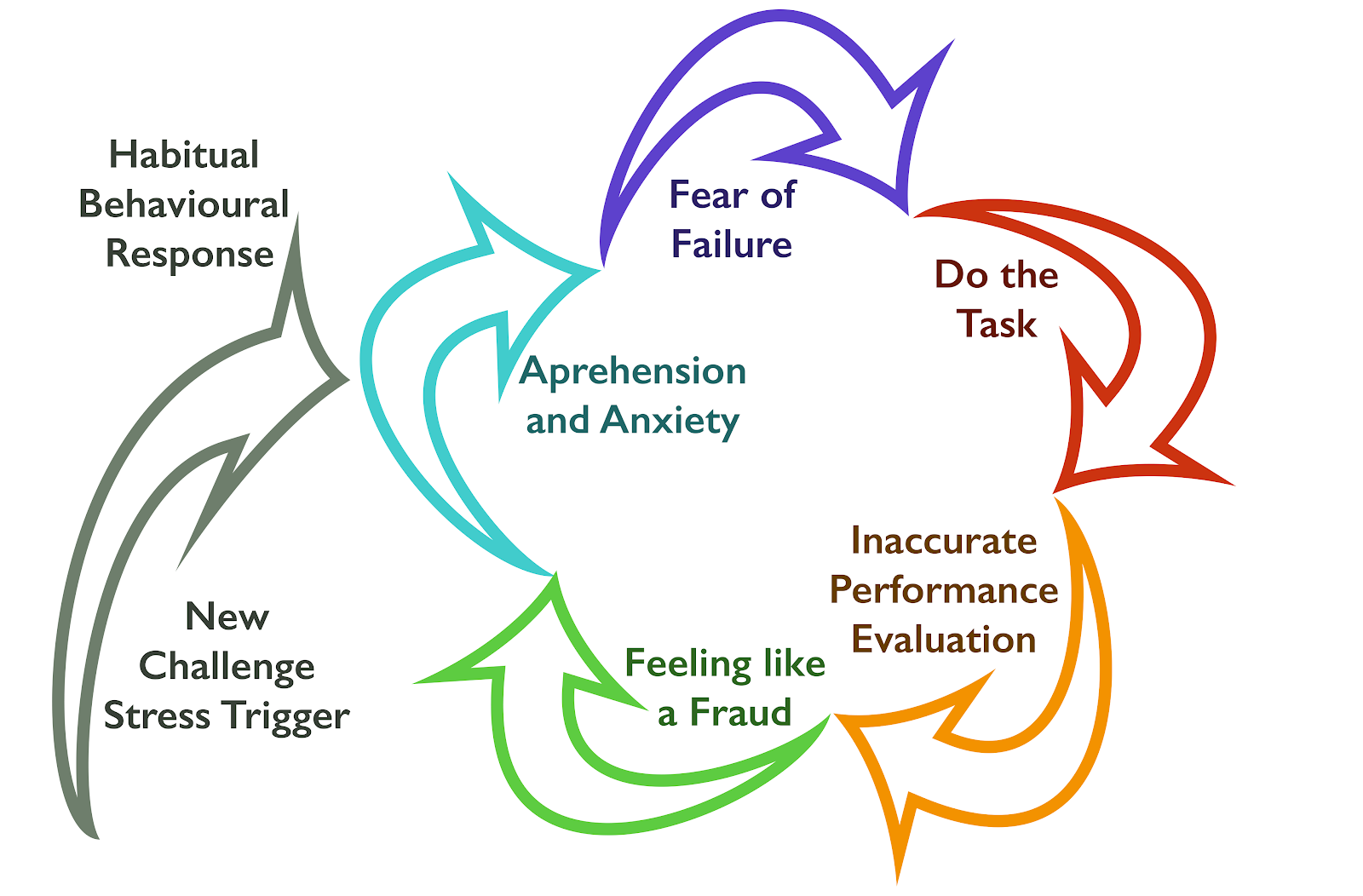
Fig. 1
The Imposter Cycle as a Vicious Circle
For HB, the new challenge[6] of professional concerts created the anxiety due to the false belief that she had to live up to someone else’s expectations. Prior to that, her music was for herself and she did not feel any obligation towards other people. The new challenge made her sense of worth conditional to the response of others. The closer the professional performance got, the more she dwelled on an imagined outcome. This became a fear of failure and possibly undermined her ability to be at her best, even though she might still have performed well. HB completed the task as the support act for the main band, believing that anxiety had prevented her from being at her best. Even though the performance might still have been really good, she evaluated the performance from an imposter’s mindset.
Her evaluation was built on assumptions filtered through the lens of her Imposter Syndrome, and failed to look at the real evidence:
- the audience’s response,
- the actual experience of the people who contracted her,
- the time it takes to learn to work in a new environment, and
- most importantly, the skills that had earned her success had not changed!
Failure to accurately evaluate her ability skewed HB’s perception of herself and created the fraud feeling. This meant that when the next new challenge, the next support gig, came she was no better prepared to deal with it than she had been the first time around. The stress of constantly feeling not good enough in front of music venue audiences became too much and she dropped out.
In the end, she did what so many musicians with IS do – she got a para-music job. A job not as a musician but within the music industry, close to what she loved but felt she could not participate in, working as a PA to a famous musician.
Avoiding the Imposter Cycle
Had HB been able to recognise situational anxiety triggers, she could have chosen to act differently, to develop a new behavioural response and avoid the IS cycle.
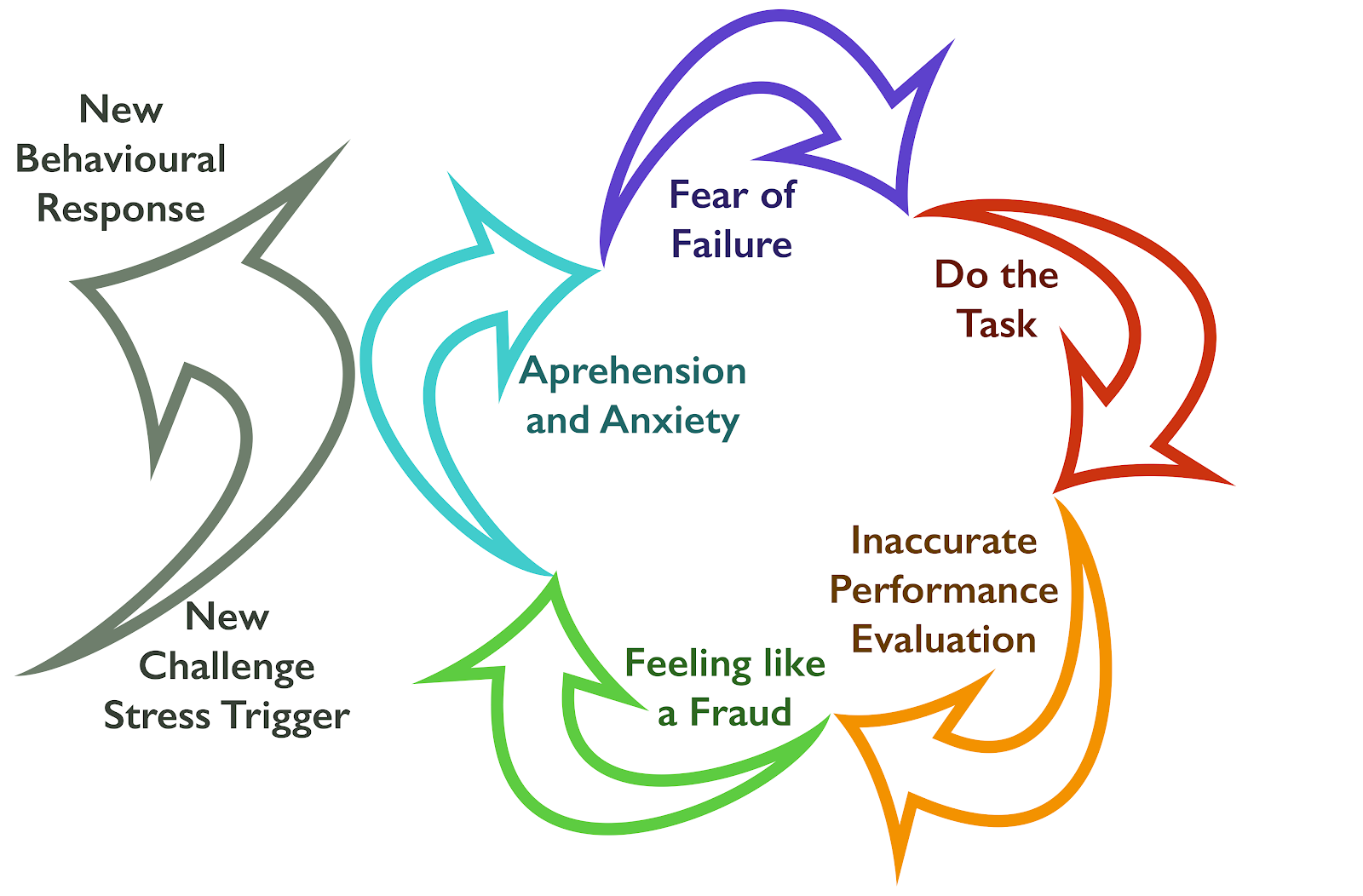
Fig. 2
This would have been easier had she internalised her values so that she had unconditional worth rather than leave her worth in the hands of others. To be calm in the moment and avoid or lessen anxiety is easier said than done. But it is easier if you have a stress reduction habit (see below).
Get off the merry-go-round
Reducing that initial rush of anxiety is important to avoid the first step of the circle.
- Recognising triggers,
- Developing new behavioural habits,
- Internalising our values,
- Having a stress reduction tool box, and
- Accurate self-evaluation
are the five elements you need to get off this horror film merry-go-round.
The story continues…
HB sought coaching to work through her Imposter Syndrome and has since learnt to see it for what it is, a self-undermining set of beliefs. While she has family commitments and cannot give up the day job, she is making music again. Because high-quality digital recording is affordable on a modest budget, she has been able to make professional demo tracks at home. Having worked for so long in the rock industry, she knows heaps of people to call on for advice, encouragement, and introductions.
The remaining two albums of her deal have long gone. But she is determined to bring out some of the music she should have and keeps telling me, “It’s better to have been a “has been” than a “never has been”.”
Moving Away From Imposter Syndrome
For the rest of this Guide, we will discuss some general strategies to help you with IS. This is not a complete list and does not go into specific exercises you might need to address the various imposter types. That would go far beyond the scope of a short guide. However, there are many good ways to get started right now.
6 Small Steps
Here are a half-dozen steps to take to move you away from IS and into a more satisfying, whole experience of your musical journey:
1. Take the Test
The peer-validated Clance Scale, designed by Dr. Pauline Rose Clance and published in 1985, is still the standard for IS assessment. Print the Clance Scale here.
You do not need to think deeply about the answers. Go with your instinctive response and add up the numbers. If you fall in the top bracket, you may want to consider help beyond this guide.
2. Stress Relief
The anxiety and fear due to IS can have an effect on stress, which can bubble up in several different ways. We can fight or flight or freeze. We can inappropriately seek power, approval, and safety. We can make an IS trigger a disproportionate drama or seek to escape from a situation rather than deal with it by sweeping it under the proverbial rug. Stress behaviours come out as lying, attacks, avoidance, playing the victim, and being needy.
The three strategies below are to help you get relief from low-level stress. If your stress is acute or in any way unmanageable, please seek help from a professional.
3. Meditation
Daily 10 to 15 minute guided meditations are a great way to take a little time out in your day. The simplest ones start by focussing on your breathing. You can then move on to physical sensations and after that working with emotions. YouTube has heaps of guided meditations and here is Deepak Chopra’s on Spotify to get started with:
4. Light-focussed exercise
Aerobic exercises are great, and light-focussed exercise is to complement them, not replace them. Exercises such as Tai Chi or Qi Gong are a great way to focus on and develop an awareness of our physical self.
5. Self-hypnosis
This would be a strategy I would only recommend after you are comfortable with meditation and are able to achieve a state of relaxation. The state of relaxation we want to achieve is similar, but what we want to do with it is very different.
6. Celebrate your Success
It does not have to cost a lot of time or money. What is important is the acknowledgement and ownership of your achievement. I like to take time out, go to a coffee shop, reflect on the successful completion of my project, and think about my next move while enjoying watching the world go by. Total cost, one double espresso and 30 minutes. The bigger the project, the bigger the celebration. If I’m feeling particularly flahoolic, I go and buy a secondhand LP.
Healing Imposter Syndrome in a Big Way
Next, we’ll look at two larger, very effective strategies of greater consequence.
Goal Setting and Imposter Syndrome
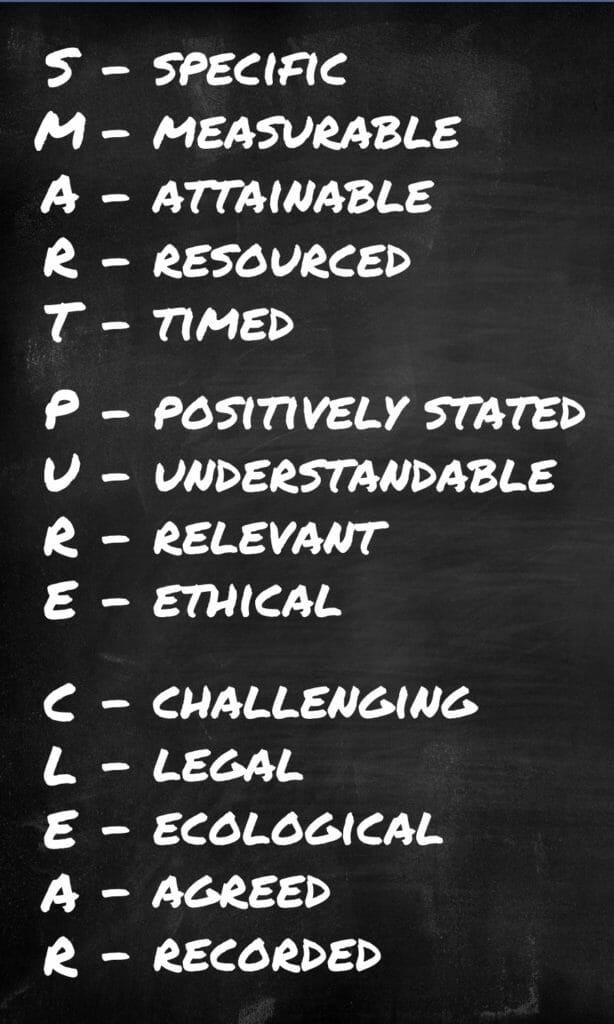 The ways and habits we’ve built around getting things done can have a large impact on how we perceive our success – or lack of it. Let’s have a look at how we can set and achieve goals with more confidence, helping us to a clearer perspective on where we are in our musical journeys.
The ways and habits we’ve built around getting things done can have a large impact on how we perceive our success – or lack of it. Let’s have a look at how we can set and achieve goals with more confidence, helping us to a clearer perspective on where we are in our musical journeys.
SMART PURE CLEAR is a goal system designed by Sir John Whitmore, the father of modern coaching. This is a common acronym for healthy, successful goal setting. And looking at the five types of imposters above, it is clear we do not always set healthy goals for ourselves.
That’s an easy one to fix.
George Harrison sang, “If you don’t know where you are going, any road will do.” Fine. So let’s make a map and work out where we want to be at the end of this process. Write a SMART PURE and CLEAR statement for your current goal in music that will help you to feel happy and fulfilled.
14 points in a goal may seem excessive. However, it’s not as excessive as the unreasonable demands you put on yourself when you don’t think through your goals properly. If your goal is particularly long-term and complex, you may want to consider chunking it into subgoals, stepping stones, to help you get there.
The 14 points of the goal keep each of the imposter types in check:
1. Specific
Include as much detail as you need to remove all ambiguities so that in 6 months you can read it and still know exactly what it is you want to achieve. Could someone who does not know you understand exactly what it is you want to achieve?
2. Measurable
How will you know when you have reached your goal?
3. Attainable
The goal is not aspirational but is founded in reality. Making a list of your past successes will help you here. Is this a challenge that will push you to be your best while at the same time has a reasonable chance of success? (Not too easy and not too tough.).
4. Resourced
Do you have access to what you need? People, materials, funds, information, and time?
5. Timed
When will you have it done by? If it is a big goal you may want to break it into subgoals and create ‘time’ staging posts.
6. Positively stated
Say “I want to be successful” instead of “I do not want to fail”. Positive statements move us towards something, are more proactive and therefore empowering. Negative statements can reflect a victim mindset. The human brain is not very good at processing negatives and sees ‘want to fail’ in the second statement – actually reaffirming a desire to fail. Can you think of other ways to use language to empower you further?
7. Understandable
Can someone else read your brief goal and understand what it is you want to achieve?
8. Relevant
In 1, 5, or 10 years time, will this goal have furthered your level of fulfilment and happiness?
9. Ethical
Is everyone who is affected by the goal respected?
10. Challenging
As well as being attainable, the goal also needs to challenge you so you have a sense of achievement and growth after completing it. If we have done it before it’s not a challenge. Ask yourself, what is new here? Where is the learning? How will I grow?
11. Legal
Hopefully this one is self-evident. If not, perhaps you should consult with a lawyer.
12. Ecological
Does the goal respect the environment it is operating in? This is not just the “green” environment, but also the social environment too.
13. Agreed
Are all parties who are connected to the goal’s implementation (and need to sign off on it) in agreement?
14. Recorded
Do you have a record of all the above points to save confusion, disputes and wasted time later?
Language
The way we express ourselves is intimately connected with how we think and feel.
We can change our thoughts, attitudes, and emotions simply by being mindful with the language we speak. This is where affirmations can be very useful. After a good practice session tell yourself, “That went really well! I nailed _______ and made good progress with _______. If I did it once, I can do it again.” Acknowledging triumphs is an important step to owning them. And if your next session does not go so well, remember when you said “If I did it once…”
The Three Languages in Alignment
 We use three languages when we communicate:
We use three languages when we communicate:
- verbal language (words),
- para-language (intonation), and
- body language (gestures and expression)
When all three work together, our communication is consistent and believable. And if they are not?
What if Kool and the Gang performed “Celebration” in a minor key at half the tempo? You probably wouldn’t believe them. It would sound like a funeral march. Or if they come back on stage for an encore mumbling “Thank you, we’ve had a wonderful time tonight” in a monotone with hunched shoulders? You’d think they were only in it for the money. More importantly, you won’t believe yourself if you do the same. The inconsistency will make you feel like a fraud.
The solution is to learn how to physically present yourself so you are the person you want to be. Body language accounts for 66% of our communication, para-language (intonation, speed, pitch and so on) is roughly 22% of how we convey meaning, and verbal language about 12%. This is such an easy thing to fix – and often overlooked. It’s like melody, harmony, and rhythm get these three language elements working together and you’ll get results. As Fun Boy sang, “It ain’t what you do, it’s the way that you do it, and that’s what gets results.”
So when you experience success, hold it in your body. Sit up, be alert, and savour the moment. New habits (depending on the source you read) can take at least 21 days to replace old responses. So this can feel awkward for quite a while. Go with it, and your body will begin to reflect your musical success.
Language Discourse
This is a huge area and goes far beyond the scope of an introductory guide, but here are a couple of things you can do to get started:
1. Use verbs actively.
Instead of “He upset me”, say “I am upset by…..”. In the first example, the hurt is done to you. You have no choice. You are a victim. In the second, as the subject, you are choosing to be upset. It is your response to a stimulus. You are now empowered and it is up to you to choose the response you want.
As an aside, this is one parents use a lot. “After everything I have done for you, this is how you thank me – by upsetting me.” Apart from making the parent look like the victim, they are also giving their child a generous helping of guilt and fueling their own IS.
2. Eliminate Negatives
We mentioned the human brain does not process negatives. Here is another example: saying “Do not walk your muddy shoes on the floor” to a child has the effect of saying “Walk your muddy shoes on the floor”, because our brain processes the simpler command, leaving out the additional negative context. It would have been better to say, “Take your shoes off at the door.” You will be met with a much higher level of compliance.
 Apply this to your musical practice. For example, instead of reminding yourself not to hit the wrong note or not to play a fuzzy barre, tell yourself the specific note you positively want to play and how you want to play it, or that you want to play a clear barre.
Apply this to your musical practice. For example, instead of reminding yourself not to hit the wrong note or not to play a fuzzy barre, tell yourself the specific note you positively want to play and how you want to play it, or that you want to play a clear barre.
Processing negatives is just one aspect of directional language. Instead of moving people away from the muddy floor, move them toward the action you want: “Take your shoes off”.
Here is a story about someone who used to be an eternal job hopper. The job he had was never right, the boss was a pain, the conditions were wrong, whatever. Everytime he left the job it was because he didn’t like it. He wanted to move away from the job rather than move towards one he really wanted. This made his CV look non-committal and better jobs to move to became harder to come by. A much better strategy is to emphasise what it is you do want (SMART CLEAR PURE) over what you do not want. You will find happiness much faster.
Final Thoughts
Through this guide, you have come to appreciate what Imposter Syndrome is and how it affects a huge number of musicians to varying degrees. You are not alone. Probably everyone has a little Imposter Syndrome in them, and you have read quotes by some very famous “imposter” musicians. It’s not all bad – if you have IS you are a fake fake! You are better than you give yourself credit for. That’s a fact. It’s people with Dunning-Kruger Syndrome[7] who are the real fakes. They are the people you do not want to be stuck in an elevator with.

Mild Imposter Syndrome’s nagging doubts will keep you on your toes and push you to be your best. It only becomes an issue when it stops us from enjoying and owning our success. It can also be a major reason as to why some musicians quit playing. This is where recalibrating your mindset is important. You have seen how many celebrated musicians reinterpret failure as learning and experimentation. Without that openness to embrace mistakes as an opportunity to learn, we cannot grow.
At its worst, while Imposter Syndrome is not a psychological condition, it can contribute to the development of disorders such as depression. If your score on the Clance Scale was low, it’s possible that this guide is all you need. If your score was at the mid-to-high end you might like to consider working with an Imposter Syndrome coach, and if your score was very high, it may be a good idea to seek help from a professional.
You saw that your imposterism has been with you a long time, since childhood. This is not to blame our parents, as they too were raised by humans – and when they were raising us, Imposter Syndrome was not widely understood, if understood at all for those over 30.
Imposter Syndrome is not one-size-fits-all. Each person expresses it according to their own recipe blending the various types of the Perfectionist, the Natural Genius, the Expert, the Soloist, and the Superhero to create their own unique cocktail. The route out of this is to:
- Start accepting and owning your success, and
- Make your worth unconditional on external events (look at strategies to internalise your worth through your values)
Next, we looked at the Imposter Syndrome Vicious Circle through the example of HB and discovered how to get out of it.
The final part of this guide introduced you to eight exercises to help you start to deal with your Imposter Syndrome. This is a journey, a process, and you will not fix it in a day, a month, or a year, but with steady work, just like music practice, you will see steady improvement.
If you are a Musical U member, there is a dedicated Imposter Syndrome discussion. Feel free to post your comments, celebrate your success, and see how other members are getting on.
One Last Exercise
This very last exercise is to help you assess your improvement. Take the Clance Scale again after a month. Then take it after 6 months, and then again after a year. Plot your scores on an XY graph (Score|Time). Tracking your improvement is probably the best way to know you are on the right path.
When taking the test in the future, do not look at your old scores in advance. Take the test and think about how you feel and behave now. As before, add up the score. How have you changed? Celebrate those improvements. This improvement is also your success. Be reasonable with accepting your success. A five score will not go to one or two in a month, but it can go in the right direction and that is what you are looking for.
Cut yourself some slack and enjoy the ride!
Footnotes
[1] That’s one of the things that is troublesome about the notion of talent. “You are so talented” reads as “It came easily to you. If it came easily to me I’d do it too.” The statement dismisses all your hard work. Playing an instrument was never going to be easy. It took hours and years to get there. It’s also an admission of laziness by the speaker. K. Anders Ericsson’s ‘Peak’ and Geoff Colvin ‘Talent is Overrated’ are both worth reading on this topic.
[2] If 70% of Fortune 500 executives express feelings of IS, then I think we can cut ourselves some slack.
[3] You can find the Clance Scale in the exercises at the end of this guide.
[4] Not speaking up and asking for your worth has big consequences. Not thinking you are good enough and not asking for a $50 per week raise over a 40 year career will cost you $100,000.
Or if you avoid taking on responsibility and that promotion, the costs of foregoing that paycheck could be even higher.
[5] Pennywise is the Clown from Stephen King’s novel “IT” who steals children. He has “an ancient cosmic evil”. Which is probably the only qualification he needs to be the driving force behind your negative thoughts.
[6] The stages of the cycle have been italicised in the text to highlight them.
[7] In some ways Imposter Syndrome and the Dunning-Kruger Effect are equal and opposite sides of the same coin. People with IS believe they are not good enough when in reality they are very competent. People with Dunning Kruger believe they are competent when in reality they know and can do very little. In fact, the main talent people with DK have is being blind to their own ignorance. These are the real fakes. People with IS only hurt themselves while people with DK run the risk of compromising everyone around them.








